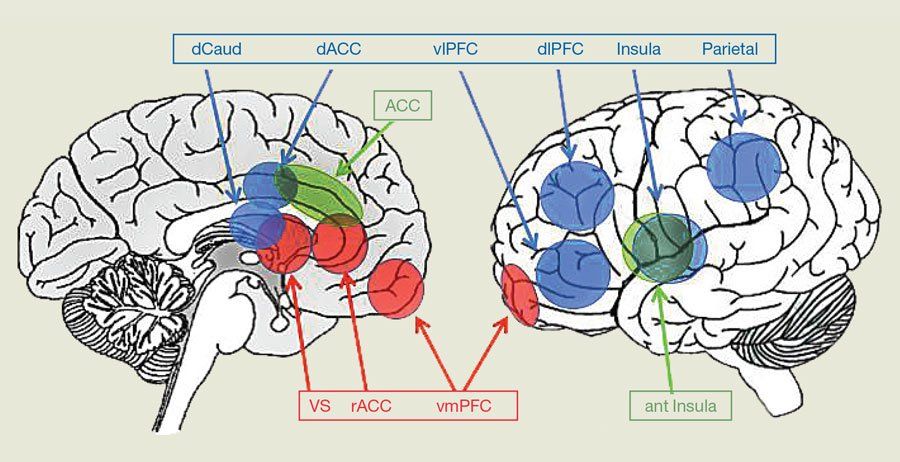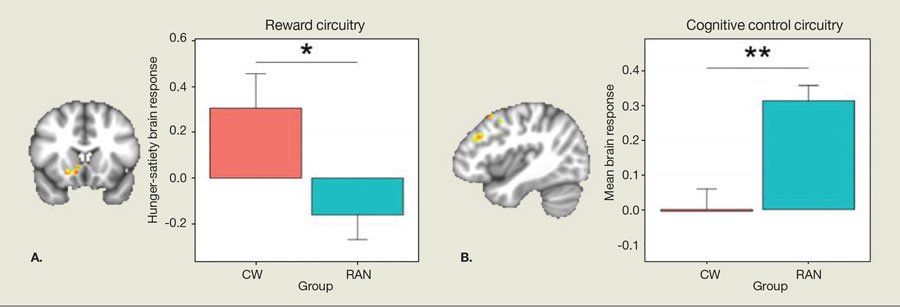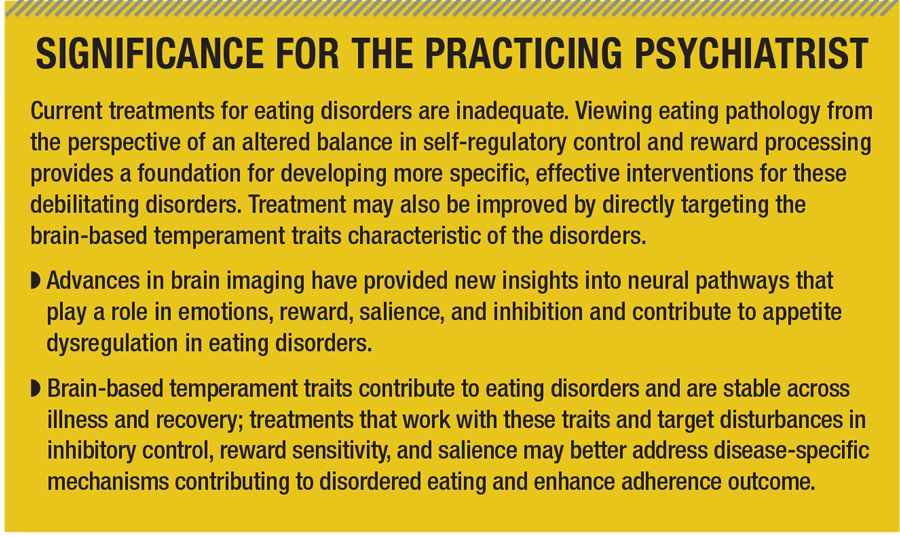Publication
Article
Psychiatric Times
Neurobiology of Eating Disorders: Clinical Implications
Author(s):
New insights into neural pathways that play a role in anorexia nervosa, bulimia nervosa, and binge eating disorder.
Figure 1. Neurocircuitry implicated in reward, inhibition, and salience [19-21] Note: Regions in red comprise reward-related neurocircuitry, including the ventral striatum (VS), rostral anterior cingulate cortex (rACC), and ventromedial prefrontal cortex (vmPFC). Regions in blue constitute the cognitive control pathway and include the dorsal caudate (dCaud), dorsal anterior cingulate cortex (dACC), ventrolateral and dorsolateral prefrontal cortex (vl and dlPFC), insula, and parietal lobe. The anterior insula (ant Insula) and anterior cingulate cortex (ACC), in green, make up the salience network.

Figure 2. Activity within the dorsolateral cognitive circuitry associated with decision-making and inhibitory control. Woman recovered from anorexia do not engage reward circuits in the brain in response to money (A), in contrast to healthy women without a history of an eating disorder, who show an increase in brain response in reward circuitry when hungry compared with when satiated. This decreased sensitivity to reward may explain why individuals with anorexia are able to ignore hunger-related urges and starve themselves. Women recovered from anorexia also show increased activation of cognitive “self-control” circuits in the brain (B), perhaps making them more effective in controlling the urge to eat.[1] CW, healthy comparison women; RAN, women recovered from anorexia nervosa. *P < .05; **P < .01; error bars represent the standard error for each group.

Significance for the Practicing Psychiatrist

Eating disorder behaviors can range from dangerous caloric restriction to eating that feels out of control-often combined with unhealthy weight control behaviors, such as self-induced vomiting or laxative abuse. Anorexia nervosa, bulimia nervosa, and binge eating disorder are the most prevalent eating disorders. Diagnostically, anorexia nervosa requires low body weight, intense fear of or behavior that interferes with weight gain, and disturbance in the perception of one’s weight or shape.
Criteria for bulimia nervosa include recurrent binge eating (eating a large amount of food in a discrete period of time accompanied by a sense of loss of control) and actions meant to counteract weight gain (eg, self-induced vomiting), as well as overvaluation of body weight or shape. Binge eating disorder involves recurrent binge eating without inappropriate compensatory behavior. Individuals with eating disorders frequently report extreme body dissatisfaction, anhedonia, anxiety, and difficulty tolerating negative emotions, although these are not required for diagnosis.
The cause of eating disorders remains unknown. Given that eating disorders reflect a discrepancy between the physiological need to eat and the drive to eat, it has been hypothesized that these individuals have a fundamental disturbance of appetite regulation. In recent years, advances in brain imaging have provided new insights into neural pathways that play a role in emotions, reward, salience, and inhibition of eating.
CASE VIGNETTE
Mabel is a 16-year-old girl who is hospitalized with unstable vital signs and a BMI of 17.5. Her family describes her as an anxious, shy, and perfectionistic child who tended to ruminate about academics, social relationships and, more recently, food. Mabel says that she has always been a picky eater. She started to lose weight after she got braces and switched to softer foods 2 years ago. She reports that her food rules became progressively more restrictive and she began exercising regularly. She became increasingly anhedonic, cognitively rigid, and sensitive to perceived criticism. She interprets her family’s efforts to support her weight restoration efforts as “nagging” and judgmental.
Current treatments-psychotherapy or pharmacotherapy-often have limited efficacy in ameliorating eating disorder symptoms and may not fully normalize eating behavior. Furthermore, many psychological interventions used to treat eating disorders are adaptations of treatments for other psychiatric disorders (eg, depression, anxiety) and were not developed for the specific, unique needs of patients with eating disorders.
The lack of a mechanistic understanding of eating disorders has thwarted efforts to develop more powerful, evidence-based interventions. Alterations in brain circuitry linked to reward and inhibition in particular appear to be involved in the maladaptive eating behavior characteristic of anorexia nervosa, bulimia nervosa, and binge eating disorder.
Neurocircuitry overview
What is it about the brains of those with eating disorders that might drive dysfunctional eating behavior? It is well known that gut and hypothalamic mechanisms contribute to the regulation of energy metabolism and eating behaviors. However, in recent years, studies in humans have revealed that higher-order, corticolimbic systems likely play a role in the pathophysiology of eating disorders.1 These systems integrate behavior with eating and can override homeostatic signals (Figure 1).
The first of these networks codes for perceived importance of a food stimulus and comprises the insula and anterior cingulate. The insula, along with the frontal operculum, also processes basic sensory information about food. The second pathway includes the nucleus accumbens, putamen, and caudate, as well as the orbitofrontal cortex and amygdala. These regions code for the rewarding and motivating value of eating and contribute to approach or avoidance behavior.
The third network helps control consumption based on consideration of both short- and long-term outcomes (eg, weight gain). It includes the dorsal caudate and dorsal anterior cingulate, lateral prefrontal cortex, and parietal cortex. These systems interactively weigh the reward value of food and the consequences of consuming it, and they integrate this information with homeostatic and motivational drives to guide eating behavior.
Mounting evidence suggests that an altered balance of reward and inhibition may contribute to disordered eating.1 In anorexia nervosa, severely restricted food intake appears to be related to overactive inhibitory control in combination with underactive reward circuitry. In contrast, dysregulation of both inhibitory and reward drives may manifest in the alternating over- and under-consumption characteristic of bulimia nervosa. Binge eating disorder may be related to altered sensitivity of ventral reward regions. Findings also suggest that these brain-based differences are linked to temperament traits, such as anxiety and harm avoidance, which persist after remission and may underlie the development of eating pathology.
Reward and salience
The brain has different responses to the anticipation and consumption of food. People with binge eating-bulimia nervosa or binge eating disorder-demonstrate reduced response when anticipating food reward in the insula and ventral striatum, but increased response to the receipt of food in these same regions. Alternatively, individuals with anorexia nervosa demonstrate increased and anxious sweet-taste anticipation in the insula, striatum, and prefrontal cortex and reduced responses in the insula and striatum to the tastes themselves.2 Differences in the way the brains of individuals with current or past eating disorders anticipate and process food rewards likely drive their approach to food.
Processing of other salient stimuli also seems to be altered, which suggests a generalized deficit. In healthy individuals, the ventral striatum and dorsal caudate typically show greater responses to reward than to punishment. In contrast, imaging research in eating disorders demonstrates dysfunctional neural valuation of reward and punishment. For example, when making choices about monetary rewards, the brains of women with histories of anorexia nervosa or bulimia nervosa don’t differentiate between wins and losses in the ventral striatal regions.3,4 Women with remission of symptoms of anorexia nervosa also show reduced reward response to money (Figure 2).5 This suggests that individuals who have eating disorders may have difficulty evaluating rewards.
Inhibition
Individuals with eating disorders also have problems with inhibitory control. Individuals with bulimia nervosa and binge eating disorder frequently demonstrate reduced inhibition that extends beyond food (eg, substance use, shoplifting, self-injury). Neuroimaging studies suggest this may relate to failure to appropriately engage frontostriatal circuits that regulate behavior. Some functional MRI (fMRI) findings show that adults and adolescents with bulimia nervosa have reduced inhibitory activation.6 Other results have shown increased activation of frontostriatal regions in adolescents with binge-purge syndromes.7 Inefficient or insufficient activation in these control-related regions may clinically manifest as difficulty in stopping eating during binge episodes, as well as difficulty in resisting urges to purge.
Enhanced cognitive control in anorexia nervosa may contribute to an ability to restrict intake even when emaciated. Recent fMRI studies of individuals with anorexia nervosa reveal increased activity within dorsolateral cognitive circuitry associated with decision-making and inhibitory control (see Figure 2).5 Although further research is needed, findings suggest that increased activation in control-related regions during the delay of gratification may underlie the extreme dietary restriction characteristic of anorexia nervosa.
CASE VIGNETTE CONT'D
Mabel explains that her difficulty with eating is driven by a lack of interest in food and increased anxiety about making meal choices. She reports that without a structured meal plan, she fasts to avoid the negative thoughts and mood that accompany eating. She also reports significant physical discomfort (eg, bloating) after eating a small amount of food. To avoid discomfort, when unsupervised, she typically eats only yogurt and small bites of fruit and vegetables in the evening. She is also quite anhedonic.
This case suggests both under- response to reward and over-control, despite extreme nutritional deprivation. It also suggests that external structure may be effective in helping Mabel restore weight.
Similarities to and differences from substance abuse
There are many similarities between substance abuse and eating disorders, particularly bulimia nervosa and binge eating disorder, including problems in the interconnected reward and inhibitory circuits. Meta-analyses suggest increased rates of drug and alcohol abuse in persons with bulimia nervosa. Women and adolescent girls with bulimia nervosa or binge eating disorder show deficient activation in brain regions related to inhibitory control similar to patterns of activation reported in drug and alcohol users.8 Moreover, the increased activation in response to food cues seen in bulimia nervosa and binge eating disorder mirrors increased activation in these regions in substance users exposed to drug-related cues.9 These similarities in brain activation may be related to underlying similarities in neurotransmitter activity: animal models of binge eating and human neuroimaging studies implicate similar neurotransmitters as those involved in substance use disorders, particularly those key to cognitive control, reward, and salience.9
In contrast, rates of drug and alcohol abuse are decreased in patients with anorexia nervosa. Individuals with anorexia nervosa demonstrate opposite patterns of neural activation in response to reward compared with persons with bulimia nervosa, binge eating disorder, or substance abuse. The over-control of individuals with anorexia nervosa, particularly those with the restricting subtype, may protect them from developing dysregulated substance use disorders.
Treatment implications
Some pharmacological treatments have shown success. Fluoxetine is currently considered the gold-standard medication for bulimia nervosa and is the only FDA-approved agent for the treatment of this disorder. Studies have shown greater amelioration of bulimia nervosa symptoms at higher dosages (60 mg/d), whether at the initiation of treatment or during rapid titration.10
Lisdexamfetamine, an appetite-suppressing amphetamine, is the only medication that is FDA-approved specifically for treating binge eating disorder. Clinical trials indicate that it leads to the cessation of binge eating behavior in up to 50% of patients.11 However, 80% of persons treated with lisdexamfetamine report significant adverse effects, and there is a risk of abuse and dependence.
Results of pharmacological treatment studies for anorexia nervosa have been mixed despite frequent off-label use.12 Psychological and behavioral treatments are necessary to fully address the complex psychological and medical syndromes associated with eating disorders. Viewing eating pathology from the perspective of an altered balance in self-regulatory control and reward processing provides a foundation for developing more specific, effective interventions for these debilitating disorders.
Current treatments for eating disorders, particularly for chronic anorexia nervosa in adults, are inadequate. Randomized, controlled trials of cognitive and psychodynamic treatments suggest that neither differs from treatment as usual in promoting weight restoration, and many patients drop out of treatment before full weight restoration.13 Strategies that focus on brain-based differences are needed, in particular to treat adult anorexia nervosa.
Treatment of adolescent anorexia nervosa is more promising: considerable evidence supports the use of family-based treatment (FBT).14 FBT is a manualized form of eating disorder–focused family therapy in which parents are enlisted to ensure appropriate food intake and other health-oriented behaviors associated with recovery. Parent utilization addresses the motivational deficits inherent in anorexia nervosa. Despite the effectiveness of this treatment in younger patients, to date there have been no published results of clinical trials of FBT in adults. Adult anorexia nervosa treatment may be improved by enlisting caretakers to oversee recovery-oriented behaviors in a modified, age-appropriate manner.
Treatment of anorexia nervosa in adults may also be improved by directly targeting the brain-based temperament traits characteristic of the disorder. Imaging studies in adults who have anorexia nervosa have shown that differences in reward processing are linked to elevated anxiety or harm avoidance.4,15 Anxious temperament and harm avoidance are present before anorexia nervosa develops, and both tend to persist after symptom remission.16,17 The combination of increased anxiety in anticipation of food and diminished brain reward response to receiving it may be what makes it so difficult for people with anorexia nervosa to eat.
If clinicians can work with these traits rather than against them, treatment effectiveness may improve.18 For example, increasing predictability and structure around meals while maintaining caloric sufficiency can potentially help mitigate anticipatory anxiety and increase compliance with meals.
CASE VIGNETTE CONT'D
After discharge from the hospital, Mabel, her mother, and her sister begin taking part in a brief intensive family treatment program. They devise a contingency management plan (eg, behavioral contract) to establish a system of external rewards and consequences to reduce eating disorder behaviors. Mabel reports decreased anxiety about meals when she knows what to expect and expresses a desire to avoid the negative consequences of reduced time with friends that is built into her contract if she engages in eating disorder behavior.
Summary
Eating disorders are chronic and debilitating illnesses, and current treatments are ineffective for many patients. Neuroimaging research suggests eating disorder symptoms may result from dysfunction in circuits underlying reward and inhibition. The brain-based temperament traits of eating disorders are stable across illness and recovery. This suggests that treatments that work with these traits and target disturbances in inhibitory control, reward sensitivity, and salience may better address disease-specific mechanisms contributing to disordered eating-and may also enhance adherence and motivation, and thereby improve outcomes.
Disclosures:
Dr Ely and Dr Berner are Postdoctoral Fellows, and Dr Wierenga is Associate Professor of Psychiatry at the University of California, San Diego. Dr Kaye is Professor and Program Director of the Eating Disorders Treatment and Research Program in the department of psychiatry at the University of California, San Diego. The authors report no conflicts of interest concerning the subject matter of this article.
References:
1. Wierenga CE, Ely A, Bischoff-Grethe A, et al. Are extremes of consumption in eating disorders related to an altered balance between reward and inhibition? Front Behav Neurosci. 2014;9:410.
2. Oberndorfer TA, Frank GK, Simmons AN, et al. Altered insula response to sweet taste processing after recovery from anorexia and bulimia nervosa. Am J Psychiatry. 2013;170:1143-1151.
3. Wagner A, Aizenstein H, Venkatraman VK, et al. Altered striatal response to reward in bulimia nervosa after recovery. Int J Eat Disord. 2010;43:289-294.
4. Wagner A, Aizenstein H, Venkatraman VK, et al. Altered reward processing in women recovered from anorexia nervosa. Am J Psychiatry. 2007;164:1842-1849.
5. Wierenga CE, Bischoff-Grethe A, Melrose AJ, et al. Hunger does not motivate reward in women remitted from anorexia nervosa. Biol Psychiatry. 2015;77:642-652.
6. Marsh R, Horga G, Wang Z, et al. An fMRI study of self-regulatory control and conflict resolution in adolescents with bulimia nervosa. Am J Psychiatry. 2011;168:1210-1220.
7. Lock J, Garrett A, Beenhakker J, Reiss A. Aberrant brain activation during a response inhibition task in adolescent eating disorder subtypes. Am J Psychiatry. 2011;168:55-64.
8. Goldstein RZ, Volkow ND. Dysfunction of the prefrontal cortex in addiction: neuroimaging findings and clinical implications. Nat Rev Neurosci. 2011;12:652-669.
9. Kaye W, Wierenga C, Bailer U, et al. Does a shared neurobiology for foods and drugs of abuse contribute to extremes of food ingestion in anorexia. Biol Psychiatry. 2013;73:836-842.
10. Fluoxetine Bulimia Nervosa Collaborative Study Group. Fluoxetine in the treatment of bulimia nervosa: a multicenter, placebo-controlled, double-blind trial. Arch Gen Psychiatry. 1992;49:139-147.
11. McElroy SL, Hudson JI, Mitchell JE, et al. Efficacy and safety of lisdexamfetamine for treatment of adults with moderate to severe binge-eating disorder: a randomized clinical trial. JAMA Psychiatry. 2015;72:235-246.
12. Aigner M, Treasure J, Kaye W, Kasper S. World Federation of Societies of Biological Psychiatry (WFSBP) guidelines for the pharmacological treatment of eating disorders. World J Biol Psychiatry. 2011;12:400-443.
13. Zipfel S, Wild B, Gross G, et al. Focal psychodynamic therapy, cognitive behaviour therapy, and optimised treatment as usual in outpatients with anorexia nervosa (ANTOP study): randomised controlled trial. Lancet. 2014;383:127-137.
14. Lock J. An update on evidence-based psychosocial treatments for eating disorders in children and adolescents. J Clin Child Adolesc Psychol. 2015;12:1-15.
15. Frank GK, Bailer UF, Henry S, et al. Increased dopamine D2/D3 receptor binding after recovery from anorexia nervosa measured by positron emission tomography and [11c]raclopride. Biol Psychiatry. 2005;58:908-912.
16. Kaye WH, Bulik CM, Thornton L, et al. Comorbidity of anxiety disorders with anorexia and bulimia nervosa. Am J Psychiatry. 2004;161:2215-2221.
17. Steinglass J, Sysko R, Mayer L, et al. Pre-meal anxiety and food intake in anorexia nervosa. Appetite. 2010;55:214-218.
18. Kaye WH, Wierenga CE, Knatz S, et al. Temperament-based treatment for anorexia nervosa. Eur Eat Disord Rev. 2015;23:12-18.
19. Craig QA. How do you feel-now? The anterior insula and human awareness. Nature Rev Neurosci. 2009;10:59-70.
20. Haber SN, Knutson SD, Paulus MP. The reward circuit: linking primate anatomy and human imaging. Neuropsychopharmacol. 2010;35:4-26.
21. Wittmann M, Lovero KL, Lane SD, Paulus MD. Now or later? Striatum and insula activation to immediate versus delayed rewards. J Neurosci Psychol Econ. 2010;3:15-26.






